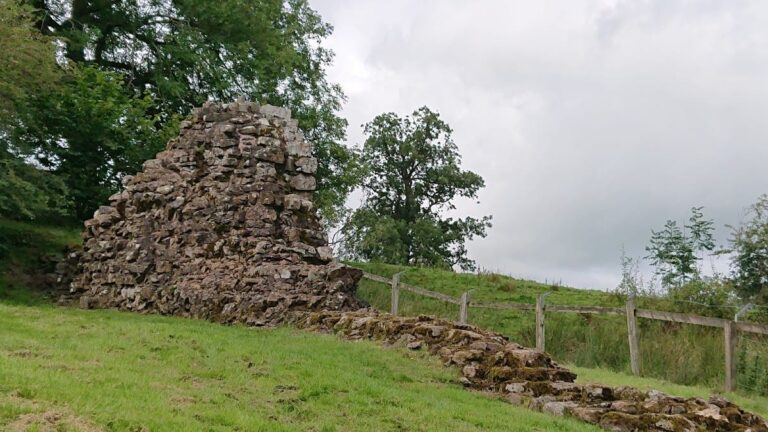Bewcastle Castle: A Norman and Medieval Fortification in England
Visitor Information
Google Rating: 4.3
Popularity: Very Low
Google Maps: View on Google Maps
Country: United Kingdom
Civilization: Unclassified
Remains: Military
History
Bewcastle Castle is situated in the parish of Bewcastle in England, near the Scottish border, and was originally established by the Normans. Its earliest incarnation was built around 1092 on the site of an earlier Roman fort called Fanum Cocidi.
The initial Norman castle was likely a timber and earthwork structure that made use of the Roman fort’s pre-existing defensive ditches on the north and east sides. This fortification was destroyed in 1173 during a period of conflict. By the late 14th century, however, the castle was rebuilt in stone. Between 1361 and 1371, John de Strivelyn led this reconstruction, sourcing much of the building material from the older Roman fortification, including the complete demolition of the fort’s northeastern corner to provide stone.
By the early 15th century, Bewcastle Castle had begun to decline. In the reign of King Edward IV, ownership passed to his brother, the Duke of Gloucester, who later became King Richard III. The Duke undertook significant restoration efforts, probably adding the gatehouse that still partially remains today. From the late 15th century onward, the Musgrave family held the castle until the mid-17th century. In 1641, under the orders of Oliver Cromwell, the castle was largely destroyed. Over time, much of the stone was repurposed for other local buildings, resulting in the ruinous state seen by the 17th century.
The place name “Bewcastle” is thought to partly originate from a legendary Anglo-Saxon figure named Bueth who lived in the 11th century, although this connection is based more on antiquarian tradition than firm historical proof. A document from 1272 references the site as “Bothecaster,” combining the Old Norse word “búð,” meaning “temporary building,” with “castle,” a reference to the Roman fort. This explains the unusual repetition contained in the name.
Remains
The remains of Bewcastle Castle lie on a rise approximately 152 meters above sea level, enveloped by grassland with flat terrain stretching to the southwest and hills in the northeast direction. Archaeological evidence confirms that the castle once occupied a site fortified by a mixture of Roman and medieval defensive works, including an enclosing dry moat. The moat’s northern and eastern stretches align with the ditches originally dug for the Roman Fanum Cocidi fort.
The most prominent surviving structure on the site is a stone gatehouse, constructed in the 14th century during John de Strivelyn’s reconstruction phase. This gatehouse is notable for its preservation and retains a projecting internal garderobe turret, essentially a medieval toilet, integrated within its design. The material used to build this gatehouse was taken from the dismantling of parts of the Roman fort, especially from the northeast corner, which was intentionally demolished to supply stone.
Today, the stone gatehouse stands almost completely intact amid the largely ruined surroundings. Much of the castle’s stonework was removed over the centuries, often reused in other nearby buildings, leaving the overall layout discernible mostly through earthworks and partial masonry. The site’s former moat, the reused Roman ditches, and the gatehouse provide a tangible link to the castle’s layered history, from its Roman origins through medieval rebuilding and eventual ruin. The grounds now serve as pastureland for sheep and llamas, maintaining the castle’s connection to the local landscape.







